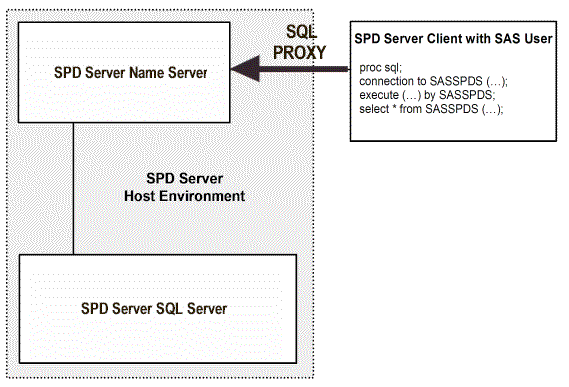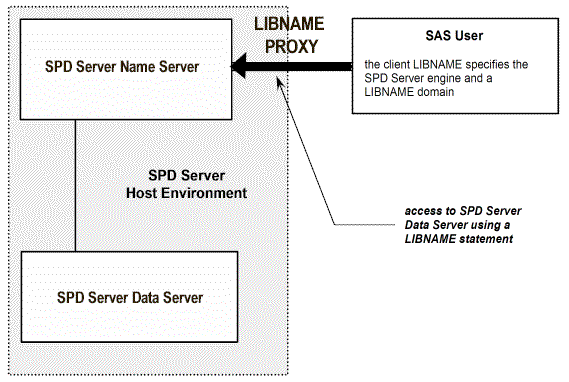Accessing SPD Server Using SAS
You begin an SPD Server session by starting your SPD
Server client. There are two ways to start your SPD Server client
session. You can use SQL pass-through commands , or you can use a
LIBNAME statement. Both ways use the SASSPDS engine and initiate communication
between the SPD Server client machine and the SPD Server host.
SQL Pass-Through Facility
SPD Server can use SQL
pass-through commands. The SPD Server host can perform complete SQL
expression evaluation. SPD Server also supports nested SQL pass-through
commands. Nested SQL pass-through commands allow you to connect to
other SPD Server hosts while you are connected to your SPD Server
host. You can use nested pass-through commands to distribute simultaneous
SQL queries across multiple SPD Server hosts on your network.
The SQL pass-through
facility can be accessed with or without SAS syntax and applications.You
can use SAS to connect to an SPD Server host by using pass-through
syntax from PROC SQL or from other SQL-aware SAS applications. Accessing and Creating SAS Scalable Performance Data (SPD) Server Tables
has more detailed information about the SPD Server pass-through facility
and provides examples of the syntax.
LIBNAME Access
SAS users can initiate
a client session by issuing a LIBNAME statement using the SASSPDS
engine. LIBNAME access is shown in Figure 1.3. Connecting to SAS Scalable Performance Data (SPD) Server
explains the mechanics of LIBNAME access to the engine and SPD Server
LIBNAME options.
SPD Server Host Name Server
Distributed computing
can enrich user resources, but it has an inherent problem. To connect
to an SPD Server, you must know its location within your network.
Instead of requiring users to memorize long paths or IP addresses,
SPD Server software uses a specialized server called a Name Server.
The SPD Server Name Server locates active SPD Server hosts on your
network. A Name Server recognizes active SPD Server machines because
all of the SPD Servers register with the Name Server as they start
up and contact the host machine.
The Name Server keeps
network addresses and a list of the LIBNAME domains for each SPD Server
host. An SPD Server LIBNAME domain is a logical entity that SPD Server
creates. A LIBNAME domain maintains domain attributes such as the
library name, owner, and contents. Whenever you use a LIBNAME statement
to specify a LIBNAME domain, a Name Server can determine the correct
directory path to the SPD Server data library and connect your SPD
Server client to the SPD Server host for that domain.
Specifying the Port Address for the Name Server
SPD Server clients use
port addressing to locate a SPD Server Name Server. SPD Server administrators
must assign a port address to a Name Server. Most UNIX system clients
use their local
/etc/services file
to register port assignments. The service name for an SPD Server Name
Server in an /etc/services file must
be SPDSNAME. PC clients use services files to register port assignments.
The services files on PC clients vary bsed on the software that the
PC network uses.
When a client SPD Server
application issues a LIBNAME statement that does not include the port
address of the Name Server, SPD Server checks the services file for
the SPDSNAME entry and the port address. Registering the Name Server
port assignment in your client's network services file relieves you
from the responsibility of coding Name Server port numbers when you
write SAS jobs. For examples of using a LIBNAME statement to connect, see LIBNAME Example Statements .

